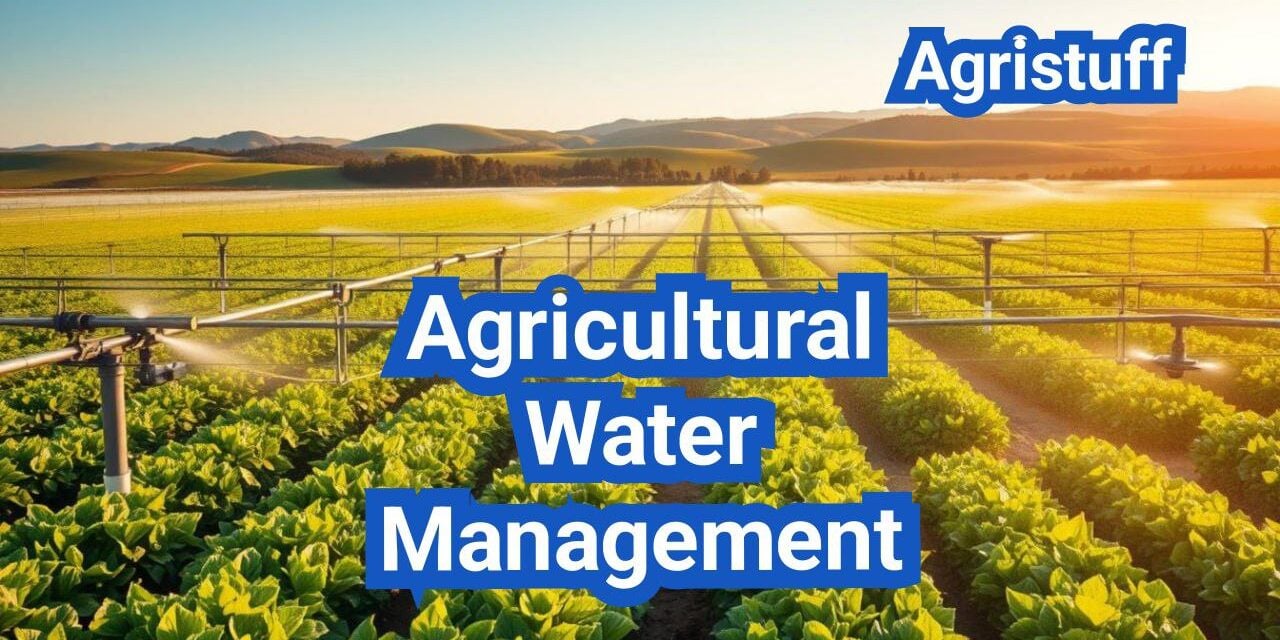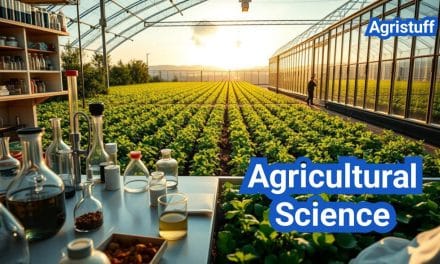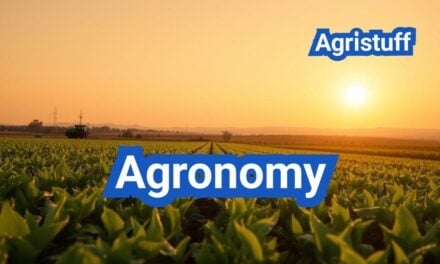Effective irrigation management is crucial for crop production, and understanding evapotranspiration (ET) and utilizing soil moisture sensors can significantly improve irrigation efficiency.
The challenges in water conservation in agriculture are multifaceted, involving economic and environmental considerations. Efficient irrigation scheduling strategies can help mitigate these challenges by optimizing crop water requirements.
Key Takeaways
- Efficient irrigation management is vital for crop production.
- Understanding ET and using soil moisture sensors improves irrigation efficiency.
- Effective irrigation scheduling strategies optimize crop water requirements.
- Water conservation in agriculture involves economic and environmental considerations.
- Proper irrigation management can mitigate challenges in water resource management.
Principles of Agricultural Water Management
The backbone of productive agriculture lies in its water management practices. Effective water management is not just about conserving water; it’s about optimizing water use to improve crop yields and quality.
Agricultural water management encompasses a range of practices and technologies aimed at efficient irrigation, water conservation, and salinity management. As the global population grows, so does the demand for food production, making efficient water management crucial for sustainable agricultural development.
Current Challenges in Water Resource Management
One of the significant challenges in agricultural water management is dealing with the variability in water supply. Droughts and changing precipitation patterns due to climate change are making it increasingly difficult for farmers to maintain consistent water supplies for their crops.
Another challenge is the issue of water quality. Irrigation water quality can significantly impact crop health and yield. Salinity, sodicity, and the presence of other contaminants can all affect the suitability of water for irrigation.
Economic and Environmental Benefits of Efficient Irrigation
Efficient irrigation practices not only conserve water but also have significant economic and environmental benefits. By optimizing water use, farmers can reduce their energy costs associated with pumping water, decrease their water bills, and potentially increase their crop yields.
Environmentally, efficient irrigation helps in reducing the environmental impact of agriculture by minimizing water waste and preventing waterlogging and salinization of soils.
| Benefit | Description | Impact |
|---|---|---|
| Water Conservation | Reducing water waste through efficient irrigation systems. | High |
| Energy Savings | Lower energy costs due to reduced water pumping. | Medium |
| Crop Yield Improvement | Optimized water application leading to better crop health. | High |
Setting Water Management Goals for Your Operation
Setting clear water management goals is essential for effective agricultural water management. These goals should be based on the specific needs of your operation, taking into account factors such as crop type, soil characteristics, and local climate conditions.
By establishing measurable objectives, such as reducing water usage by a certain percentage or improving crop water productivity, farmers can better manage their water resources and make informed decisions about irrigation practices.
Understanding Evapotranspiration (ET) in Crop Production

Understanding evapotranspiration is essential for optimizing irrigation practices in crop production. Evapotranspiration (ET) represents the combined process of water evaporation from the soil and transpiration from plants, playing a crucial role in determining crop water requirements.
What is Evapotranspiration and Why It Matters
Evapotranspiration is a critical component of the hydrological cycle in agricultural ecosystems. It is influenced by various factors including climate, soil type, and crop characteristics. “Accurate ET estimation is vital for irrigation management, as it directly affects crop yield and water use efficiency,” as noted by irrigation experts.
The significance of ET lies in its ability to help farmers and agricultural managers make informed decisions about irrigation scheduling. By understanding the ET rate, farmers can apply the right amount of water at the right time, thus optimizing water use and reducing waste.
Reference ET vs. Crop ET
There are two key concepts related to ET: Reference Evapotranspiration (ETo) and Crop Evapotranspiration (ETc). ETo is a measure of the evaporative demand of the atmosphere, independent of crop type and management practices. It serves as a baseline to estimate ETc, which is the actual evapotranspiration of a specific crop under given conditions.
The relationship between ETo and ETc is defined by the crop coefficient (Kc), where ETc = ETo * Kc. This coefficient varies by crop type, growth stage, and local conditions, making it a crucial factor in irrigation planning.
Seasonal Variations in ET Rates
ET rates vary significantly across different seasons due to changes in weather conditions, such as temperature, humidity, and solar radiation. During the growing season, ET rates typically peak during periods of high temperature and low humidity.
Understanding these seasonal variations is key to developing effective irrigation scheduling strategies. By adjusting irrigation according to the ET rates, farmers can ensure that crops receive adequate water throughout the growing season, thereby enhancing crop productivity and water efficiency.
Working with Crop Coefficient (Kc) Tables
To optimize irrigation, it’s vital to understand how to work with crop coefficient tables. Crop coefficient (Kc) tables are essential for determining the water requirements of various crops, allowing farmers and agricultural managers to make informed irrigation decisions.
How to Use Kc Values for Different Crops
Crop coefficients are used to estimate the evapotranspiration (ET) of specific crops. The Kc value represents the ratio of crop ET to reference ET. To use Kc tables effectively, one must first identify the correct Kc value for the crop in question.
Step 1: Identify the crop type and its growth stage.
Step 2: Consult a reliable Kc table that lists the crop coefficients for different growth stages.
Step 3: Apply the Kc value to calculate the crop’s ET using the reference ET data.
Adjusting Kc Values for Local Conditions
While Kc tables provide a general guideline, local conditions such as climate, soil type, and irrigation practices can affect the actual Kc value. Adjusting Kc values for these conditions is crucial for accurate irrigation scheduling.
- Consider the local climate and its impact on ET rates.
- Adjust for soil type and its water-holding capacity.
- Account for specific irrigation practices and their effects on crop water use.
Common Mistakes in Applying Crop Coefficients
When using crop coefficients, several common mistakes should be avoided to ensure accurate irrigation management.
| Mistake | Consequence | Correction |
|---|---|---|
| Using Kc values without adjusting for local conditions | Inaccurate ET estimates | Adjust Kc values based on local climate, soil, and irrigation practices |
| Not updating Kc values for different growth stages | Incorrect irrigation scheduling | Regularly update Kc values as the crop progresses through its growth stages |
| Ignoring the impact of weather events on ET | Over or under-irrigation | Monitor weather forecasts and adjust irrigation schedules accordingly |
By understanding how to use Kc tables, adjusting for local conditions, and avoiding common mistakes, agricultural managers can significantly improve their irrigation management practices, leading to more efficient water use and better crop yields.
Soil Moisture Sensor Technology and Selection

Effective irrigation management relies heavily on accurate soil moisture monitoring. Soil moisture sensors are a critical tool in precision agriculture, enabling farmers to make informed decisions about irrigation scheduling. By providing real-time data on soil moisture levels, these sensors help optimize water use, reduce waste, and improve crop yields.
Types of Soil Moisture Sensors
There are several types of soil moisture sensors available, each with its own strengths and limitations. The most common types include:
- Capacitance Sensors: These sensors measure soil moisture by detecting changes in the dielectric constant of the soil.
- Tensiometers: Tensiometers measure the soil water tension, providing an indication of the energy required by plants to extract water from the soil.
- Time-Domain Reflectometry (TDR) Sensors: TDR sensors measure the soil moisture by analyzing the reflections of electromagnetic pulses.
- Resistance Sensors: These sensors measure the electrical resistance between two electrodes buried in the soil, which correlates with soil moisture.
Placement Strategies for Accurate Readings
Proper placement of soil moisture sensors is crucial for obtaining accurate readings. Factors to consider include soil type, crop root depth, and irrigation system layout. Sensors should be placed in areas representative of the field conditions and at depths that correspond to the root zone of the crops.
| Soil Type | Recommended Sensor Depth | Sensor Placement Considerations |
|---|---|---|
| Sandy Soils | 12-18 inches | More frequent readings needed due to high drainage rates |
| Clay Soils | 18-24 inches | Less frequent readings; consider water-holding capacity |
| Loamy Soils | 15-20 inches | Balance between water-holding capacity and drainage |
Wired vs. Wireless Systems
The choice between wired and wireless soil moisture sensor systems depends on several factors, including the size of the operation, the complexity of the irrigation system, and the need for real-time data access. Wired systems are often more reliable and less prone to interference, while wireless systems offer greater flexibility and ease of installation.
By understanding the different types of soil moisture sensors, their placement strategies, and the advantages of wired versus wireless systems, farmers and agricultural managers can make informed decisions about their irrigation management practices, leading to more efficient water use and improved crop productivity.
Step-by-Step Soil Moisture Sensor Calibration
Accurate soil moisture sensor calibration is crucial for effective irrigation management. Calibration ensures that the sensor readings accurately reflect the soil moisture levels, allowing for precise irrigation scheduling.
Field Calibration Procedures
Field calibration involves adjusting the sensor to match the specific soil conditions. This process typically includes:
- Collecting soil samples around the sensor
- Measuring the volumetric water content of these samples
- Comparing these measurements with the sensor readings
- Adjusting the sensor settings to match the actual soil moisture levels
It’s essential to follow a systematic approach to ensure accurate calibration.
Soil-Specific Calibration Considerations
Different soils have unique properties that affect sensor readings. For instance, soils with high clay content may require different calibration parameters compared to sandy soils. Soil texture, organic matter content, and salinity levels are critical factors to consider during calibration.
| Soil Type | Calibration Factor | Notes |
|---|---|---|
| Sandy Loam | 1.2 | Well-draining soils may require higher calibration factors |
| Clay Loam | 0.8 | Soils with higher water-holding capacity may need lower factors |
| Silty Clay | 0.9 | Soils with high silt content may require moderate adjustments |
Troubleshooting Common Calibration Issues
Calibration issues can arise due to various factors, including sensor placement, soil heterogeneity, and equipment malfunctions. Common problems include:
- Inconsistent readings across different soil depths
- Sensor drift over time
- Interference from nearby electrical sources
Addressing these issues promptly is crucial for maintaining the accuracy of the irrigation management system.
By following these step-by-step calibration procedures and considering soil-specific factors, farmers and irrigation managers can ensure that their soil moisture sensors provide accurate data. This, in turn, enables more efficient irrigation management and contributes to the overall goals of precision agriculture.
Developing Effective Irrigation Scheduling Plans

To maximize crop yields while minimizing water waste, farmers need to implement effective irrigation scheduling strategies. This involves a comprehensive approach that takes into account various factors, including evapotranspiration (ET) data, soil moisture readings, and weather forecasts.
Combining ET Data with Soil Moisture Readings
One of the key elements in developing an effective irrigation scheduling plan is combining ET data with soil moisture readings. ET data provides insights into the water needs of crops, while soil moisture readings offer real-time information on the moisture levels in the soil. By integrating these two data sources, farmers can make informed decisions about when and how much to irrigate.
Benefits of Combining ET Data and Soil Moisture Readings:
- Improved water use efficiency
- Enhanced crop health and productivity
- Reduced water waste and environmental impact
Creating Season-Long Irrigation Calendars
Creating a season-long irrigation calendar is another crucial aspect of effective irrigation scheduling. This involves planning and scheduling irrigation events over the entire growing season, taking into account factors such as crop growth stages, soil type, and anticipated weather conditions.
Steps to Create a Season-Long Irrigation Calendar:
- Determine the water requirements of the crop at different growth stages
- Assess the soil’s water-holding capacity
- Plan irrigation events based on ET data and weather forecasts
- Regularly review and adjust the calendar as needed
Adjusting Schedules for Weather Events
Flexibility is key when it comes to irrigation scheduling. Farmers must be prepared to adjust their irrigation schedules in response to weather events such as rainfall, heatwaves, or cooler-than-expected temperatures. By continuously monitoring weather forecasts and soil moisture levels, farmers can make timely adjustments to their irrigation plans.
Strategies for Adjusting Irrigation Schedules:
- Utilize real-time weather data and forecasts
- Monitor soil moisture levels closely
- Be prepared to irrigate during dry spells or withhold irrigation during wet periods
Implementing the Checkbook Irrigation Method
Effective irrigation management is crucial for agricultural productivity, and the checkbook method offers a systematic approach. This method involves meticulous record-keeping and calculation of various factors that influence irrigation needs.
Setting Up Your Water Balance Sheet
The first step in implementing the checkbook irrigation method is to set up a water balance sheet. This involves tracking the inflows and outflows of water in your irrigation system. Initial soil moisture, rainfall, and irrigation applications are considered inflows, while evapotranspiration (ET) and deep percolation are outflows.
To create an effective water balance sheet, you need to:
- Determine the initial soil moisture content
- Record daily rainfall and irrigation amounts
- Calculate daily ET rates
- Account for deep percolation losses
Daily ET Calculations and Record Keeping | Agricultural Water Management
Daily ET calculations are a critical component of the checkbook irrigation method. ET represents the amount of water lost through evaporation and transpiration. Accurate ET data helps in making informed irrigation decisions.
To calculate daily ET, you can use the following formula:
| Parameter | Description | Unit |
|---|---|---|
| ETo | Reference Evapotranspiration | mm/day |
| Kc | Crop Coefficient | – |
| ETc | Crop Evapotranspiration | mm/day |
Integrating Rainfall and Irrigation Events
Integrating rainfall and irrigation events into your water balance sheet is essential for accurate irrigation management. Rainfall can significantly contribute to soil moisture, reducing the need for irrigation. Conversely, irrigation events should be planned based on soil moisture deficits.
To effectively integrate these factors:
- Monitor rainfall forecasts and actual rainfall
- Adjust irrigation schedules based on rainfall and soil moisture levels
- Maintain detailed records of both rainfall and irrigation events
By following the checkbook irrigation method and maintaining a comprehensive water balance sheet, farmers can optimize irrigation management, reduce water waste, and improve crop productivity.
Applying Deficit Irrigation Strategies

The application of deficit irrigation strategies requires a deep understanding of crop stress tolerance. Deficit irrigation involves supplying water below the crop’s full evapotranspiration (ET) needs, which can lead to significant water savings. However, it’s crucial to identify the right periods for deficit irrigation to avoid negatively impacting crop yields.
Identifying Crop-Specific Stress Tolerance Periods
Different crops have varying levels of stress tolerance at different growth stages. For instance, some crops are more sensitive to water stress during flowering and grain filling stages. Understanding these critical periods is essential for implementing deficit irrigation effectively.
Crop Stress Tolerance Stages:
- Critical stress-sensitive stages: Flowering, grain filling
- Moderately sensitive stages: Vegetative growth
- Less sensitive stages: Maturation
Regulated Deficit Irrigation Techniques
Regulated deficit irrigation (RDI) is a strategy that involves applying water deficit during specific growth stages that are less sensitive to water stress. This technique requires precise irrigation scheduling and monitoring of soil moisture levels.
Measuring Yield Impact vs. Water Savings
One of the key challenges in implementing deficit irrigation is balancing yield impact against water savings. Farmers need to assess the economic benefits of water savings against potential yield reductions.
By carefully planning and monitoring deficit irrigation strategies, farmers can achieve a balance between water conservation and maintaining crop productivity.
Distribution Uniformity Testing and Improvement

Ensuring uniform water distribution is crucial for efficient irrigation management. Distribution uniformity testing is a critical process that helps farmers and irrigators assess the effectiveness of their irrigation systems.
Distribution uniformity refers to how evenly water is applied across the irrigated area. Poor distribution uniformity can lead to overwatering in some areas and underwatering in others, negatively impacting crop yields and water efficiency.
Field Testing Methods for Different Irrigation Systems
There are several methods for conducting distribution uniformity tests, depending on the type of irrigation system in use. For sprinkler irrigation systems, catch cans are typically used to measure water application rates across the field.
- For center pivot systems, catch cans are placed along a radial line from the pivot point to the outer edge.
- In drip irrigation systems, emission uniformity is tested by measuring the flow rate from a sample of emitters.
- For surface irrigation, distribution uniformity is often assessed by measuring the depth of water infiltrated along the field.
Interpreting DU Test Results | Agricultural Water Management
Once the distribution uniformity test is completed, the results need to be analyzed to determine the irrigation system’s performance. The Distribution Uniformity (DU) coefficient is calculated by dividing the average of the lowest quarter of measurements by the overall average measurement.
A higher DU value indicates better uniformity. Typical DU values range from 0.6 to 0.9, with higher values representing more uniform water distribution.
| DU Value | Irrigation Uniformity |
|---|---|
| 0.6-0.7 | Poor |
| 0.7-0.8 | Fair |
| 0.8-0.9 | Good |
Cost-Effective Improvements for Better Uniformity
Improving distribution uniformity can lead to significant water savings and increased crop yields. Some cost-effective strategies include:
- Regular maintenance of irrigation equipment to prevent wear and tear.
- Adjusting sprinkler nozzles and pressures to optimize water distribution.
- Upgrading to more uniform irrigation systems or components.
- Implementing proper irrigation scheduling based on crop water needs.
By implementing these improvements, farmers can enhance irrigation efficiency, reduce water waste, and promote sustainable agricultural practices.
Optimizing Center Pivot Irrigation Efficiency

To maximize crop yields while minimizing water waste, farmers must optimize their center pivot irrigation systems. Center pivot irrigation is a widely used method in modern agriculture, offering significant advantages in terms of water distribution and labor efficiency.
Pressure Regulation and Nozzle Selection
One of the critical factors in optimizing center pivot irrigation is pressure regulation. Proper pressure ensures uniform water distribution across the field. Incorrect pressure can lead to either under-irrigation (if pressure is too low) or over-irrigation and runoff (if pressure is too high).
Nozzle selection is equally important. Nozzles come in various sizes and types, and choosing the right one depends on factors like soil type, crop water requirements, and the specific irrigation system design. Using the correct nozzles can significantly improve irrigation uniformity and reduce water waste.
Variable Rate Irrigation Implementation
Variable Rate Irrigation (VRI) is an advanced technology that allows farmers to vary the application rate of water across different parts of the field. This is particularly useful in fields with varying soil types, slopes, or other conditions that affect water needs.
Implementing VRI involves several steps, including:
- Mapping the field to identify areas with different irrigation needs
- Installing VRI-capable control systems on the center pivot
- Adjusting irrigation rates according to the mapped zones
Maintenance Practices for Peak Performance
Regular maintenance is crucial for ensuring that center pivot irrigation systems operate at peak efficiency. This includes:
| Maintenance Task | Frequency | Benefits |
|---|---|---|
| Inspecting and cleaning nozzles | Monthly | Ensures uniform water distribution |
| Checking pivot alignment and tires | Quarterly | Prevents mechanical issues and ensures smooth operation |
| Lubricating moving parts | Bi-annually | Reduces wear and tear on the system |
By implementing these optimization strategies, farmers can significantly improve the efficiency of their center pivot irrigation systems, leading to better crop yields and reduced water consumption.
Drip Irrigation Maintenance and Management
Effective drip irrigation maintenance is crucial for maximizing water efficiency in agricultural settings. Drip irrigation systems, while highly efficient, require regular upkeep to ensure they operate at peak performance. Proper maintenance not only conserves water but also extends the lifespan of the irrigation system.
Filtration System Requirements | Agricultural Water Management
A critical component of drip irrigation maintenance is the filtration system. Filtration systems are essential for removing particles and contaminants from the water that could clog the drip emitters. The type of filtration required depends on the water source and the specific irrigation system design.
- Screen filters are commonly used for clean water sources.
- Media filters are more effective for water with higher levels of contaminants.
- Disc filters offer a balance between screen and media filters, suitable for a variety of water conditions.
Regular cleaning and maintenance of the filtration system are vital to prevent clogging and ensure uniform water distribution.
Flushing Protocols and Schedules | Agricultural Water Management
Flushing is a critical maintenance task for drip irrigation systems. It involves removing sediment and debris that accumulate in the pipes and emitters. Regular flushing helps maintain system efficiency and prevents clogging.
- Flush the mainline and sub-mains at the beginning of each irrigation season.
- Perform periodic flushing during the irrigation season, especially after heavy use or rainfall events.
- Use appropriate flushing velocities to effectively remove debris.
Establishing a flushing schedule based on the system’s specific needs and water quality can significantly reduce maintenance issues.
Detecting and Repairing Leaks | Agricultural Water Management
Leaks in drip irrigation systems can lead to water loss, reduced system pressure, and uneven water distribution. Regular inspections are necessary to detect leaks early. Common signs of leaks include:
- Unexpected wet spots in the field.
- Reduced system pressure.
- Increased water flow rates without explanation.
Once a leak is detected, it’s crucial to repair it promptly. This may involve replacing damaged emitters, fixing leaks in the lateral lines, or tightening loose connections.
By following these maintenance guidelines, farmers and irrigators can ensure their drip irrigation systems operate efficiently, conserve water, and support healthy crop growth.
Calculating Leaching Requirements for Salinity Management
Calculating leaching requirements is a vital step in managing soil salinity and ensuring sustainable agricultural practices. Leaching is the process of applying water to the soil to remove excess salts and maintain a healthy salt balance. Effective leaching requires careful planning and management to achieve the desired salinity levels without wasting water.
Soil and Water Testing for Salinity
Before determining leaching requirements, it’s essential to assess the current salinity levels in both the soil and irrigation water. Soil testing involves collecting samples from various depths to measure the electrical conductivity (EC) of the soil saturation extract. Water testing also measures EC to determine its salinity level. These tests provide crucial data for calculating the leaching fraction.
Soil salinity testing can be done using various methods, including:
- Electrical conductivity (EC) measurements
- Soil sampling at different depths
- Laboratory analysis
Leaching Fraction Determination
The leaching fraction is the proportion of irrigation water that needs to be applied in excess of crop evapotranspiration (ET) requirements to maintain a desired soil salinity level. It’s calculated based on the salinity of the irrigation water and the tolerance of the crop to salinity. A higher leaching fraction is required for crops sensitive to salinity and when using more saline irrigation water.
| Crop | Salinity Tolerance (dS/m) | Leaching Fraction Required |
|---|---|---|
| Wheat | 6 | 0.1 |
| Cotton | 7.5 | 0.15 |
| Alfalfa | 2 | 0.05 |
Timing Leaching Events for Maximum Effectiveness
The timing of leaching events is crucial for their effectiveness. Leaching should be done during periods when soil moisture is low, and crop ET demand is minimal. This strategy helps in maximizing the downward movement of water through the soil profile, thus enhancing salt removal.
Farmers should also consider weather forecasts to avoid leaching during periods of expected rainfall, as this can naturally contribute to leaching and reduce the need for additional irrigation.
By understanding and implementing these strategies, farmers can effectively manage soil salinity, improve crop yields, and contribute to sustainable water use practices.
Managing Salinity in Arid Region Agriculture

Managing salinity is crucial for sustainable agriculture in arid regions. High salt levels in the soil can significantly reduce crop yields and affect farm productivity. Effective salinity management involves a combination of strategies including salt-tolerant crop selection, soil amendments, and appropriate irrigation practices.
Salt-Tolerant Crop Selection | Agricultural Water Management
Choosing crops that are tolerant to high salt levels is a critical step in managing salinity. Salt-tolerant crops can thrive in conditions where other crops would fail, helping to maintain agricultural productivity. Some examples of salt-tolerant crops include:
- Barley
- Sorghum
- Certain varieties of wheat
- Alfalfa
When selecting salt-tolerant crops, it’s essential to consider factors such as the crop’s growth stage sensitivity to salt, the soil’s salinity level, and the local climate conditions.
Soil Amendments for Salinity Mitigation | Agricultural Water Management
Soil amendments can play a significant role in mitigating the effects of salinity. Amendments such as gypsum can help improve soil structure and reduce salt concentrations. The application of organic matter can also enhance soil’s water-holding capacity and promote beneficial microbial activity.
Some common soil amendments used for salinity mitigation include:
- Gypsum
- Organic compost
- Manure
The choice of amendment depends on the soil type, the level of salinity, and the specific needs of the crops being grown.
Irrigation Practices for Salt Management
Proper irrigation practices are vital for managing salt in the soil. Techniques such as drip irrigation can help minimize salt accumulation by delivering water directly to the roots of plants. Leaching, or the application of excess water to flush out salts, is another effective strategy.
Key irrigation practices for salt management include:
- Drip irrigation
- Leaching
- Monitoring soil moisture levels
By adopting these practices, farmers can reduce the impact of salinity on their crops and maintain soil health.
Assessing Irrigation Water Quality: EC and SAR
Assessing irrigation water quality is crucial for effective agricultural water management. Irrigation water quality can significantly impact crop health, soil condition, and overall farm productivity. Two key parameters in assessing irrigation water quality are Electrical Conductivity (EC) and Sodium Adsorption Ratio (SAR).
Interpreting Water Test Results
When interpreting water test results, understanding EC and SAR values is essential. EC measures the water’s ability to conduct electricity, which is directly related to its salinity. SAR, on the other hand, measures the relative concentration of sodium to calcium and magnesium. High SAR values can lead to soil dispersion and reduced permeability.
EC and SAR Thresholds:
| Parameter | Low Risk | Moderate Risk | High Risk |
|---|---|---|---|
| EC (dS/m) | < 0.7 | 0.7 – 3.0 | > 3.0 |
| SAR | < 6 | 6 – 9 | > 9 |
Managing High EC/SAR Water Sources
Managing irrigation water with high EC or SAR requires careful planning. For high EC water, strategies include blending with lower EC water, using salt-tolerant crops, and implementing leaching programs to manage soil salinity. For high SAR water, applying gypsum can help mitigate the adverse effects on soil structure.
Treatment Options for Problem Water | Agricultural Water Management
Several treatment options are available for managing problem water. These include physical treatments like filtration and sedimentation, chemical treatments such as chlorination or acidification, and biological treatments. The choice of treatment depends on the specific water quality issues and the intended use of the water.
Effective management of irrigation water quality is a critical component of sustainable agricultural practices. By understanding and addressing EC and SAR issues, farmers can improve crop yields, reduce soil degradation, and conserve water resources.
Accessing NRCS EQIP Funding for Irrigation Improvements
Improving irrigation efficiency is crucial for sustainable agriculture, and NRCS EQIP funding can help make this a reality. The Environmental Quality Incentives Program (EQIP) provided by the Natural Resources Conservation Service (NRCS) offers financial assistance to farmers and agricultural producers to implement conservation practices, including irrigation improvements.
Eligibility Requirements and Application Process
To access NRCS EQIP funding, applicants must meet specific eligibility requirements. These typically include being an agricultural producer, having a conservation plan, and being in compliance with environmental regulations. The application process involves submitting a proposal that outlines the planned irrigation improvements and how they align with EQIP’s conservation objectives.
Key steps in the application process include:
- Determining eligibility and gathering required documents
- Developing a detailed conservation plan that includes irrigation improvements
- Submitting the application through the NRCS online portal or local office
Qualifying Irrigation Efficiency Practices
NRCS EQIP funding supports a variety of irrigation efficiency practices, including the adoption of advanced irrigation technologies and systems that reduce water usage. Examples of qualifying practices include:
- Installing drip irrigation systems or micro-irrigation
- Upgrading to precision irrigation technologies
- Implementing soil moisture monitoring systems
It’s essential to consult with NRCS officials to ensure that the proposed irrigation improvements qualify for EQIP funding.
Documentation and Reporting Requirements | Agricultural Water Management
Recipients of NRCS EQIP funding are required to maintain detailed records of their irrigation improvements and report on their progress. This includes documenting the implementation of conservation practices, monitoring water usage, and reporting any changes in irrigation management.
Proper documentation is crucial for:
- Ensuring compliance with EQIP requirements
- Evaluating the effectiveness of irrigation improvements
- Facilitating future applications for EQIP funding
Building a Sustainable Water Management Program
Effective agricultural water management is crucial for sustainable crop production and environmental stewardship. By implementing a comprehensive water management program, farmers and agricultural professionals can optimize irrigation practices, reduce water waste, and promote water conservation.
A well-designed water management program incorporates various tools and techniques, including evapotranspiration (ET) data, soil moisture sensors, and irrigation scheduling plans. By combining these elements, agricultural producers can make informed decisions about irrigation management, leading to improved crop yields and reduced environmental impact.
Building a sustainable water management program requires a thorough understanding of agricultural water management principles, as well as a commitment to ongoing monitoring and evaluation. By adopting best management practices and leveraging available resources, such as NRCS EQIP funding, agricultural producers can develop effective irrigation management strategies that support long-term sustainability.
By prioritizing sustainable water management, the agricultural community can help ensure a more water-resilient future, balancing crop production needs with environmental stewardship and conservation goals.
FAQ
What is agricultural water management, and why is it important?
Agricultural water management refers to the practices and techniques used to manage water resources for crop production. It is crucial for ensuring efficient irrigation, reducing water waste, and promoting sustainable agriculture.
How does evapotranspiration (ET) impact crop production?
ET is the process by which plants release water vapor into the air. Understanding ET is essential for effective irrigation scheduling, as it helps farmers determine the optimal amount of water to apply to their crops.
What are crop coefficient (Kc) tables, and how are they used?
Kc tables provide a way to estimate the water requirements of different crops based on their growth stage and environmental conditions. By using Kc values, farmers can adjust their irrigation schedules to meet the specific needs of their crops.
How do soil moisture sensors work, and what are their benefits?
Soil moisture sensors measure the moisture levels in the soil, providing farmers with real-time data to inform their irrigation decisions. This can help reduce water waste, improve crop health, and increase yields.
What is the checkbook irrigation method, and how does it work?
The checkbook irrigation method involves tracking the water balance in the soil, taking into account factors like ET, rainfall, and irrigation events. This approach helps farmers make informed decisions about when and how much to irrigate.
What is deficit irrigation, and how can it be applied?
Deficit irrigation involves intentionally reducing irrigation amounts to stress crops during specific growth stages. This can help conserve water while maintaining yields, but requires careful planning and monitoring.
How can distribution uniformity testing improve irrigation efficiency?
Distribution uniformity testing helps identify areas where irrigation systems are not applying water evenly. By addressing these issues, farmers can improve the overall efficiency of their irrigation systems.
What are the benefits of optimizing center pivot irrigation efficiency?
Optimizing center pivot irrigation efficiency can help reduce energy costs, conserve water, and improve crop yields. This can be achieved through techniques like pressure regulation, nozzle selection, and variable rate irrigation.
How can drip irrigation systems be maintained and managed effectively?
Regular maintenance, including flushing protocols and leak detection, is essential for ensuring the longevity and efficiency of drip irrigation systems.
What is leaching, and how is it used for salinity management?
Leaching involves applying excess water to the soil to remove salts and other minerals. By calculating the leaching requirement, farmers can determine the optimal amount of water to apply to manage salinity.
How can irrigation water quality be assessed, and what are the implications for crop production?
Irrigation water quality can be assessed by testing for factors like EC and SAR. Understanding water quality is crucial for managing salinity, reducing the risk of crop damage, and maintaining soil health.
What is NRCS EQIP funding, and how can it be accessed?
NRCS EQIP funding is a program that provides financial assistance to farmers for implementing conservation practices, including irrigation improvements. Eligibility requirements and application processes vary, but can help support sustainable agriculture practices.
What are some best practices for building a sustainable water management program?
Building a sustainable water management program involves implementing efficient irrigation practices, monitoring water use, and adapting to changing environmental conditions. By combining these approaches, farmers can reduce their environmental impact while maintaining productivity.
How can smart irrigation tools and apps support agricultural water management?
Smart irrigation tools and apps can provide farmers with real-time data and insights to inform their irrigation decisions. These technologies can help optimize water use, reduce waste, and improve crop yields.
What role does soil moisture monitoring play in agricultural water management?
Soil moisture monitoring is critical for understanding soil water dynamics and making informed irrigation decisions. By using soil moisture sensors and other monitoring tools, farmers can optimize their irrigation practices and reduce water waste.
Conclusion of: Agricultural Water Management
What is agricultural water management and why it matters
At its core, agricultural water management means deciding how much water to apply, when to apply it, and how to apply it so crops get what they need without wasting a drop or harming soils and aquifers. In the United States, this discipline is formalized in NRCS Conservation Practice Standard Code 449, which frames agricultural water management as the process of determining and controlling irrigation volume, frequency, and rate for crop, soil, and water-quality goals. NRCS Irrigation Water Management (Code 449)
The U.S. water context for agricultural water management
Sound agricultural water management is also an economic reality: the latest USDA 2023 Irrigation & Water Management Survey shows 212,714 farms irrigated 53.1 million acres using about 81 million acre-feet, with clear momentum toward efficiency and better scheduling practices across U.S. operations. These national snapshots help growers benchmark their own agricultural water management plans. USDA NASS 2023 Irrigation Highlights
ET 101: the backbone of agricultural water management
Evapotranspiration (ET) combines evaporation from soil and plant canopies with transpiration from leaves; using ET to drive agricultural water management ties irrigation timing and amount to actual crop water use. FAO’s classic FAO-56 text remains the global reference for estimating crop water need via reference ET (ETo) and crop coefficients (Kc). FAO-56: Crop Evapotranspiration
Standardized reference ET for agricultural water management
For agricultural water management in the U.S., the ASCE-EWRI standardized reference ET equations (short-crop ETo / tall-crop ETr) are widely used to calculate a consistent climatic driver for scheduling. This standardization makes ET-based decisions comparable across stations and tools. ASCE Standardized Reference ET (PDF)
Crop coefficients (Kc) adapt ET to your crop in agricultural water management
Reference ET becomes crop ET (ETc) when multiplied by Kc, which changes across growth stages; getting Kc right is essential for precise agricultural water management. The FAO-56 dual Kc method separates soil evaporation and plant transpiration to improve accuracy, especially under partial cover or frequent irrigation. FAO-56 Dual Kc Method (Annex)
Reliable ET data feeds agricultural water management decisions
Public ET networks make agricultural water management practical: the Bureau of Reclamation’s AgriMet provides station-level ET summaries and crop water use charts calibrated for local conditions across the West and Pacific Northwest. USBR AgriMet: Crop Water Use & ET
From ET to the “checkbook”: scheduling in agricultural water management
Many growers run agricultural water management with a simple daily soil-water “checkbook”: start with the root-zone water amount, subtract ETc, add rainfall/irrigation, and irrigate when the allowable depletion threshold is reached. Extension guides walk this step-by-step. UNL: How Crop ET Guides Irrigation
Soil moisture sensors: a second pillar of agricultural water management
ET models predict demand; sensors show what’s actually in the root zone—together they strengthen agricultural water management. Capacitance and TDR sensors report volumetric water content; matric potential sensors (e.g., granular matrix) indicate how hard roots must pull water. UMN: Soil Moisture Sensors for Scheduling
Picking sensor tech for agricultural water management
When selecting sensors for agricultural water management, weigh installation depth, soil texture, salinity sensitivity, data logging, and budget. University guides compare options, setup, and thresholds for triggering irrigations across crops and soils. OSU: Soil Moisture Sensing Systems
Where to place sensors for agricultural water management
Good readings drive good agricultural water management: locate sensors in representative zones, avoid wheel tracks and low spots, and stagger depths within the active root zone. Research-based placement and depletion thresholds keep decisions consistent. Virginia Tech: Sensor Placement & Thresholds (PDF)
Marrying ET and sensors in agricultural water management
Best-in-class agricultural water management fuses ET-based checkbooks with soil data: let ET forecast demand and use sensors to validate timing and run time, adjusting for rainfall, wind, and canopy changes. Simple mobile tools make this hybrid approach accessible. WSU: Irrigation Scheduler Mobile Manual (PDF)
System choice and efficiency in agricultural water management
Your agricultural water management outcomes depend on the system: drip and microirrigation often deliver higher application efficiencies and precise placement, whereas pivots excel at uniform coverage and labor savings; either can waste water without proper scheduling. CSU Extension: Drip Irrigation Overview
Distribution uniformity (DU) is a hidden lever in agricultural water management
Uniformity determines how evenly the system spreads water—if low, some plants are stressed while others are overwatered, defeating good agricultural water management. DU (or emission uniformity in drip) is a standard way to quantify and improve this. UC ANR: Microirrigation Uniformity
Testing and tuning uniformity for agricultural water management
Simple catch-can tests on pivots or micros let you quantify DU and target fixes—nozzle swaps, pressure regulation, flushing, filter maintenance—so agricultural water management decisions actually reach the crop as intended. Alabama Extension: Maintaining Uniformity
Deficit and limited irrigation within agricultural water management
Under constraints, agricultural water management may strategically under-irrigate outside critical stages to stretch supplies while protecting yield and quality, especially in corn and other field crops—this requires stage-wise ET and soil monitoring. UNL: Corn Irrigation Under Water-Limiting Conditions (PDF)
Salinity control and leaching in agricultural water management
Where salts accumulate, agricultural water management includes a calculated leaching fraction to push salts below the root zone, balancing soil health with water protection; university guides show how to size and time these leaching irrigations. UC ANR: Managing Salts by Leaching (PDF)
Irrigation water quality in agricultural water management
Assess EC, SAR, bicarbonate, chloride, nitrate, and trace ions to avoid infiltration issues and toxicity—proper sampling and interpretation are part of every agricultural water management plan, especially in arid and reclaimed-water contexts. Penn State Extension: Interpreting Irrigation Water Tests
Measuring water and keeping records in agricultural water management
Flow meters, pressure gauges, and maintenance logs turn agricultural water management into continuous improvement: track volumes, verify pivot output, catch pump performance drifts, and document compliance using established water-measurement methods. USBR Water Measurement Manual (PDF)
Pumping energy and costs in agricultural water management
Because lift, pressure, and run time drive energy use, agricultural water management often pairs scheduling with pump efficiency and rate comparisons; NRCS’s Energy Estimator helps visualize savings from improved scheduling and hardware upgrades. NRCS: Energy Estimator—Irrigation
Scheduling tools that operationalize agricultural water management
Digital tools translate climate and soil data into decisions so agricultural water management becomes routine: Kansas State’s KanSched monitors a root-zone water balance using ET, rainfall, and irrigation to suggest when/amount. K-State: KanSched 3
Crop- and region-specific decision support in agricultural water management
For specialty crops and California conditions, agricultural water management can tap UC ANR’s CropManage, which integrates local research, weather, and crop stage to recommend irrigation (and nitrogen) in a web app. UC ANR: CropManage
Build a simple, written agricultural water management plan
Formalizing agricultural water management improves results and eligibility for programs: map fields and systems, set thresholds (MAD), list tools (ET source, sensors), document flow/pressure checks, and keep event-by-event records using a standard template. NRCS IWM Plan Template (PDF)
Programs that can support agricultural water management investments
Growers in the West and priority basins should explore funding that accelerates agricultural water management upgrades—NRCS’s EQIP WaterSMART Initiative complements Bureau of Reclamation WaterSMART projects to boost efficiency and reliability. NRCS WaterSMART Initiative
Common mistakes that undercut agricultural water management
Even strong plans fail without verification: uncalibrated or clogged nozzles, inaccurate flow meters, ignored pressure drops, and skipped maintenance all erode agricultural water management. Use meter readings and pivot walk-throughs to catch issues early. UNL: Using Your Irrigation Flow Meter
A quick corn example to ground agricultural water management
For Midwestern corn on a pivot, agricultural water management often targets higher soil water during tassel/silk and early grain fill, then tapers toward black layer; ET-based checkbooks and sensors help time the final irrigation precisely. UMN: Predicting the Last Irrigation
Monitoring drought and climate signals within agricultural water management
To keep agricultural water management resilient, monitor drought indices and seasonal outlooks; coupling scheduling with drought dashboards helps plan allocations, staging, and contingency leaching across variable seasons. U.S. Drought Portal
Final thought
If you remember one thing about agricultural water management: combine standardized ET, trustworthy soil data, uniform delivery, and written schedules—then verify with meters and pivot/nozzle checks. That integrated loop is what consistently protects yield, water, and energy in real-world operations. NRCS IWM Standard (Code 449)
Sources & References
- FAO-56: Crop Evapotranspiration
- ASCE-EWRI Standardized Reference ET (PDF)
- FAO-56 Dual Kc Method (Annex)
- USBR AgriMet: Crop Water Use & ET
- UNL: Crop ET in Decisions
- UMN: Soil Moisture Sensors
- Virginia Tech: Sensor Placement (PDF)
- WSU: Irrigation Scheduler Manual (PDF)
- CSU: Drip Irrigation Overview
- UC ANR: Microirrigation Uniformity
- Alabama Extension: Uniformity
- UNL: Corn Under Water-Limiting Conditions (PDF)
- UC ANR: Managing Salts by Leaching (PDF)
- Penn State: Water Test Interpretation
- USBR Water Measurement Manual (PDF)
- NRCS: Energy Estimator—Irrigation
- K-State: KanSched
- UC ANR: CropManage
- NRCS WaterSMART Initiative
- UNL: Flow Meter as a Management Tool
- U.S. Drought Portal
- USDA NASS 2023 Irrigation Highlights (PDF)
- NRCS IWM Standard (Code 449) (PDF)










